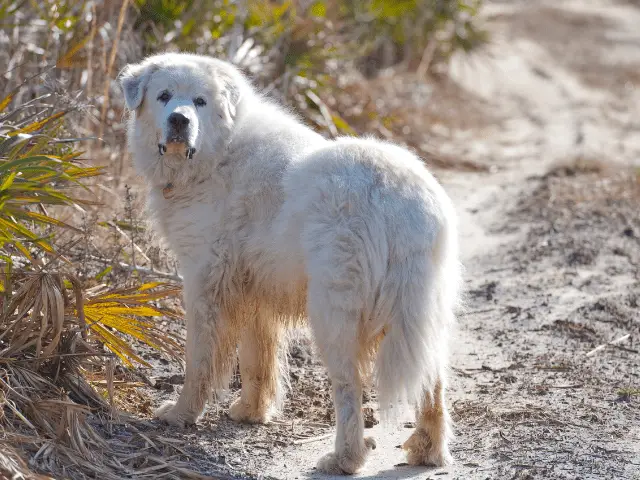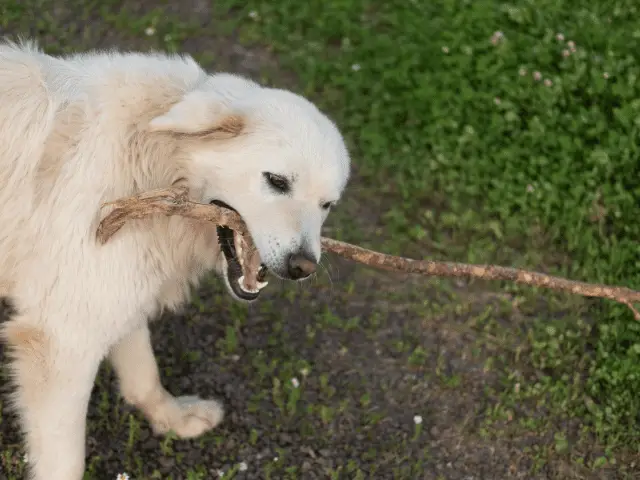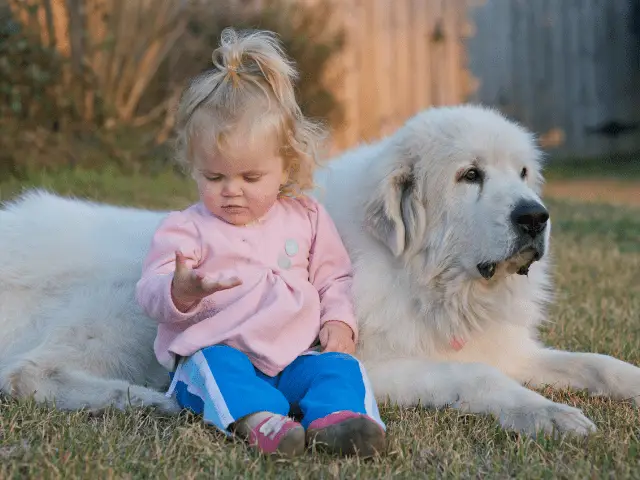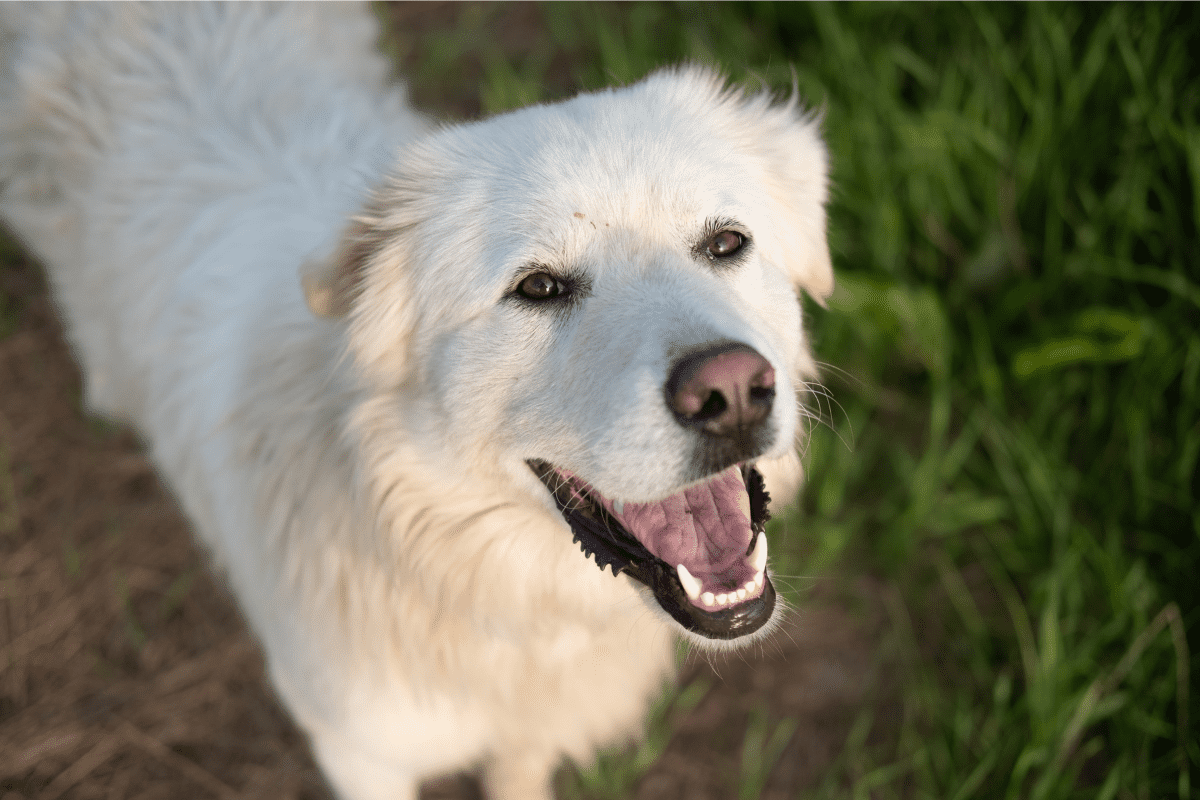The Great Pyrenees is aptly named. These dogs stand between two and three feet tall, weigh over 100 pounds, and have a massive double coat which exaggerates their large appearance; they are physically and mentally strong; and they have big personalities, which can run a bit amuck in the hands of the wrong owner.
In short, being a Great Pyrenees owner isn’t something you should undertake lightly. It requires knowledge of the breed, and of dogs in general, as well as a lot of patience.
All of that said, the Great Pyrenees is a wonderful companion, especially for an active, outdoorsy owner, if you know what you’re doing. The breed, which gets its name from the Pyrenees mountain range in France and Spain, were bred as shepherding dogs, a job they have excelled at for centuries.
In addition to their usefulness in assisting shepherds with livestock, their regal appearance earned them a position as the “royal dog” of France in the 1400s, which contributed to a significant rise in the breed’s popularity. They were used to develop and re-develop several other breeds across Europe, before being introduced to the United States about 100 years ago.
This history has made the Great Pyrenees a determined, strong-willed working dog, willing to take on and see through any job given to them. They are highly intelligent, and while they are perhaps too stubborn to be called “gentle”, they are loving dogs that get along well with other animals as well as people.
All of these personality traits, along with their physical capabilities, make them a great dog to have by your side on your adventures, once you know enough about them to feel confident.
Great Pyrenees as Hiking Companions

The Great Pyrenees was developed as a shepherd’s dog, where they would spend their days outdoors, walking amongst the flocks of sheep and protecting them from predators. This makes them perfect hiking companions, as they are well-adapted to be active and alert, typically in the mountains and at higher-than-typical elevations, for long hours at a time.
They should have no difficulty on any hiking trail you choose to bring them to; although their pace may not match your own at all times, they will keep up with you on average and have an eye on you even if they are a bit ahead or behind.
Great Pyrenees dogs have a lot of energy, which is one of the biggest potential problems for new dog owners, but hiking is a great way to get them the exercise they need.
When physically and mentally satisfied by a long, active adventure, they will be able to settle in at home and happily accompany your other daily activities, even those that are less exciting than hiking. Conveniently, this makes it easy to gauge whether your Great Pyrenees is getting an appropriate amount of exercise from their hikes with you.
Another potential bonus of having a Great Pyrenees as a hiking companion (although it hopefully won’t come up often) is that they will protect you if any dangers should present themselves. Of course, the best way to stay safe is to try to avoid wild animals, like snakes and bears as much as possible.
Many dogs are protective of their owners and families and respond to perceived dangers accordingly, but as a shepherding dog, the Great Pyrenees is actually prepared, mentally as well as physically, to protect you and keep you safe if necessary.
As their family, they consider you their charge to take care of, so they will keep you close by even if not kept on a short leash and alert you to anything that arouses suspicion.
Hiking with A Great Pyrenees

Hiking with a Great Pyrenees is quite an experience. It’s a good experience, if you’re prepared for it, but it can be different from hiking with other breeds.
The Great Pyrenees is alert at all times while hiking, and aware of the presence of other animals and people. They are playful and loving with those they know, and they will be excited to encounter friends (dog friends or human friends) on your excursions. But, they will be wary of strangers at their first encounters, and it’s up to you to guide their behavior with others.
With their impressive senses of smell and hearing, they will likely notice other hikers and wildlife before you do, so be prepared to respond to their alerts even when you don’t see anything there.
They will probably bark, and they may be insistent about their suspicions and their protective behavior, but they are not aggressive unless a truly dangerous animal presents itself and forces them into a conflict.
They also have incredible endurance, and although they could make do with half an hour or an hour of walking every day, they will just as easily hike with you from sunrise to sunset.
As a giant breed, they can cover long distances more efficiently, and combined with their athletic history, this makes them a force to be reckoned with. They aren’t sprinters, but for long-distance treks, they are one of the best dogs to have by your side, and you will probably be the one to need to turn around first.
Great Pyrenees dogs can even be great companions for nighttime hikes, as they would often have to stay awake at night while protecting a flock of sheep and have no difficulty remaining alert and active after dark. Basically, no matter what kind of hike you have in mind, the Great Pyrenees is always willing and able to join you.
Temperament and Behavior

The temperament and natural behavioral tendencies of the Great Pyrenees are what give new Great Pyrenees owners the most trouble. They are sweet dogs, and they will love and protect you immediately once they become part of your family, but they are also intelligent and stubborn.
Remember, they were bred to lead and guard flocks of sheep, so it was easiest for the shepherds if the dogs were able to take charge and make their own decisions. As a result, most Great Pyrenees dogs today still want to be able to take charge in this way, and they will not default to your authority the way that some other breeds might.
Without training, a Great Pyrenees can be a difficult dog to manage or take anywhere.
They naturally want to be in charge of any situation, which may lead them to be bossy with other dogs and even with people. They like to wander off on their own to explore, they will bark to ward off other animals, and they can even steal food from the table, the trash, or the pantry as soon as you turn your back.
The key to managing Great Pyrenees behavior is proper socialization, with both people and dogs, and serious training.
They can be difficult dogs to train, because they are so stubborn that they don’t like to do as they’re told at first, but they are intelligent enough to respond to commands very well if you have the patience to see the training through. They may take longer to train than other dogs, not because they can’t learn quickly but because they choose not to.
However, once they do accept the training, they will retain it well and for a long time.
How to Prepare for Your Hike
The two keys to preparing for a hike with your Great Pyrenees are the same as the keys to managing their behavior in general: socialization and training.
Great Pyrenees dogs are naturally independent. They work alone, as the only dog among a group of sheep, with one or a few shepherds somewhere nearby, and they will be perfectly happy to be the only dog in your household.
However, socializing them with other dogs is still important if you want them to be able to behave in public and on hikes, where you are sure to encounter other dogs at least some of the time.
They are also strong-willed, and training them can be a slow process, but it is the most important thing you can do to prepare for hiking with them. You should train at least basic obedience commands, like “sit”, “stay”, and “heel”, and remember to be patient with them.
They can take a while to learn new commands, and while they are learning, they may be slow to respond. Rather than repeating your commands, give them time to process and respond, and reward them when they eventually do. They will get faster with practice, so don’t give up on them!
Finally, remember that your attitude matters a lot when it comes to training a Great Pyrenees. It’s important to stay positive, as frustration will only make the process unpleasant for both of you. You also need to be confident and firm, especially if your Great Pyrenees tries to ignore commands that you know they have learned.
Although they instinctively take on the role of leader, they are capable of accepting that you are the real authority of the household, but only if you demonstrate this to be so. Be patient, be consistent, and above all, have fun.
All your hard work will pay off when you are hiking with a perfect Great Pyrenees companion.
Have More Dogs in Your Pack?
If you have more dogs in your pack, other than your Great Pyrenees – make sure to check out our other breed guides for hiking. We have guides for all types of breeds, ranging from Yorkies to Australian Cattle Dogs. With dozens of guides (and more being added all the time), there is a good chance we have all the info you need!

